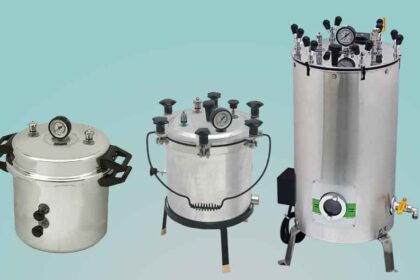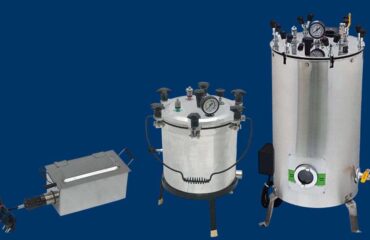
A laboratory autoclave is a device used to sterilize equipment, media, and other items in scientific labs through high-pressure saturated steam. The process eliminates bacteria, viruses, fungi, and spores, ensuring a sterile environment for experiments and procedures.
How It Works:
- Loading: Items are placed inside the autoclave chamber, usually in trays or wrapped in special autoclave-safe materials.
- Heating: The autoclave heats water to produce steam, which fills the chamber and raises the temperature.
- Pressurizing: The chamber is sealed, and pressure increases (typically to about 15 psi), allowing the temperature to rise above 121°C (250°F).
- Sterilization: The items are held at high temperature and pressure for a specific time (usually 15–20 minutes).
- Cooling & Venting: After the cycle, the pressure is released, and items are cooled before being safely removed.
Common Uses:
- Sterilizing glassware, metal tools, and pipette tips.
- Preparing culture media in microbiology labs.
- Disposing of biological waste safely.
- Sterilizing medical equipment in clinical settings.
Types of Laboratory Autoclaves
Vertical Autoclaves
Design & Features:
- Top-loading design, with a cylindrical or rectangular chamber.
- Compact and space-saving, suitable for small labs.
- Equipped with manual or automatic controls for temperature and pressure.
Applications:
- Ideal for liquid sterilization (e.g., culture media).
- Frequently used in microbiology, pharmaceutical, and food testing labs.
- Perfect for small batches of glassware or lab instruments.
Pros:
- Affordable and compact.
- Easier to fit in limited lab space.
Cons:
- Limited capacity compared to larger models.
- Loading/unloading can be cumbersome for heavy items.
Horizontal Autoclaves
Design & Features:
- Front-loading design, similar to industrial ovens.
- Comes in cylindrical or rectangular shapes, often with larger capacities.
- More advanced control systems with programmable cycles and digital displays.
Applications:
- Suitable for large-scale sterilization in research institutions, hospitals, and industrial labs.
- Used for bulk sterilization of glassware, instruments, and even textiles.
Pros:
- Higher capacity for large volumes.
- Easier to load/unload compared to vertical autoclaves.
Cons:
- Requires more space.
- Higher cost due to advanced features.
Benchtop Autoclaves
Design & Features:
- Compact, tabletop units.
- Often have automatic cycles with user-friendly digital controls.
- Lower volume capacity but highly portable.
Applications:
- Used in dentist offices, clinics, and small labs for sterilizing small instruments and tools.
- Suitable for quick sterilization of small batches, like pipette tips or petri dishes.
Pros:
- Portable and easy to use.
- Quick sterilization cycles.
Cons:
- Limited capacity—not ideal for large labs.
Double-door (Pass-through) Autoclaves
Design & Features:
- Designed with two doors to allow sterile transfer between two areas, like from a non-sterile environment to a cleanroom.
- Common in pharmaceutical manufacturing and biotechnology labs.
- Equipped with advanced safety interlocks to prevent both doors from opening simultaneously.
Applications:
- Essential in cleanroom environments for aseptic processing.
- Used in biosafety labs handling hazardous materials to prevent contamination.
Pros:
- Maintains strict contamination control.
- Highly automated with advanced sterilization cycles.
Cons:
- Expensive and requires significant space.
- Complex installation and maintenance.
Portable Autoclaves
Design & Features:
- Small, lightweight units, often manually operated.
- Sometimes powered by electricity or even gas burners in fieldwork conditions.
Applications:
- Ideal for field research, remote clinics, or emergency situations.
- Suitable for basic sterilization needs when lab infrastructure isn’t available.
Pros:
- Highly portable and versatile.
- Doesn’t require complex setup.
Cons:
- Limited sterilization capacity.
- Less precise control over temperature and pressure.
High-capacity Industrial Autoclaves
Design & Features:
- Large-scale autoclaves used in industrial or research facilities.
- Highly customizable with specialized sterilization cycles for complex materials.
Applications:
- Used in pharmaceutical manufacturing, veterinary labs, or agriculture research.
- Suitable for sterilizing large equipment, animal cages, or biohazardous waste.
Pros:
- Handles massive loads in a single cycle.
- Advanced features for specialized sterilization processes.
Cons:
- Very expensive.
- Requires significant infrastructure, maintenance, and training.
Gravity Displacement Autoclaves
Design & Features:
- Utilizes gravity to remove air from the chamber as steam fills it.
- Simpler and more economical but less effective for porous loads.
Applications:
- Great for sterilizing non-porous items like glassware, metal tools, and liquids.
Pros:
- Simple, cost-effective, and reliable.
- Lower maintenance requirements.
Cons:
- Not suitable for items like fabric or wrapped instruments that trap air.
Vacuum (Pre-vacuum) Autoclaves
Design & Features:
- Uses a vacuum pump to remove air before steam enters, ensuring deeper penetration into porous materials.
- More complex and efficient than gravity autoclaves.
Applications:
- Ideal for wrapped instruments, textiles, and hollow items like pipettes.
- Common in medical, dental, and research labs.
Pros:
- More effective sterilization of complex or porous loads.
- Faster drying time due to vacuum cycle.
Cons:
- Higher cost and more maintenance.
- Requires more sophisticated infrastructure.
Choosing the Right Autoclave:
| Type | Best For | Capacity | Complexity |
| Vertical | Small labs, liquid sterilization | Small to Medium | Low |
| Horizontal | Large research labs, bulk loads | Medium to Large | Medium |
| Benchtop | Clinics, small labs | Small | Low |
| Double-door (Pass-through) | Cleanrooms, biosafety labs | Medium to Large | High |
| Portable | Fieldwork, remote areas | Small | Low |
| Industrial | Large-scale, industrial settings | Very Large | High |
| Gravity Displacement | Simple tools, liquids | Small to Medium | Low |
| Vacuum (Pre-vacuum) | Porous/hollow items, wrapped tools | Medium to Large | High |
Conclusion:
Laboratory autoclaves are essential tools for ensuring sterilization in various scientific, medical, and industrial settings. With a wide range of types—such as vertical, horizontal, benchtop, double-door, portable, gravity displacement, and vacuum autoclaves—each caters to specific sterilization needs based on load size, material type, and environmental requirements.
Vertical and benchtop autoclaves are perfect for small labs or clinics needing compact, efficient sterilization.
Horizontal and high-capacity autoclaves serve larger institutions requiring bulk sterilization of diverse materials.
Double-door autoclaves are critical in controlled environments like cleanrooms, ensuring contamination-free transfer.
Gravity displacement autoclaves are cost-effective for simple sterilization tasks, while vacuum autoclaves excel at sterilizing porous or wrapped items.
Choosing the right autoclave depends on factors like capacity requirements, types of materials, frequency of use, and budget. Understanding the features and applications of each type helps optimize laboratory workflows, ensuring safety and efficiency in sterilization processes.
